Aerial refueling: also called air-to-air refueling and in-flight refueling. You can’t send a B-2 from Missouri to hit a high-priority ISIS target in Libya without it; nor can you deploy an expeditionary air wing to a combat zone in Afghanistan or the Middle East. Aerial refueling allows receiving aircraft to fly long distances or stay on station for hours. Because receiver aircraft can be topped up once airborne, you can launch with less fuel and more payload, getting around takeoff weight restrictions. On long-distance flights, up in the thin cold air where jet engines are most efficient, air refueling gives you such improved fuel economy it more than makes up for the cost of staging tankers along the way. You can’t have an effective air force without it.
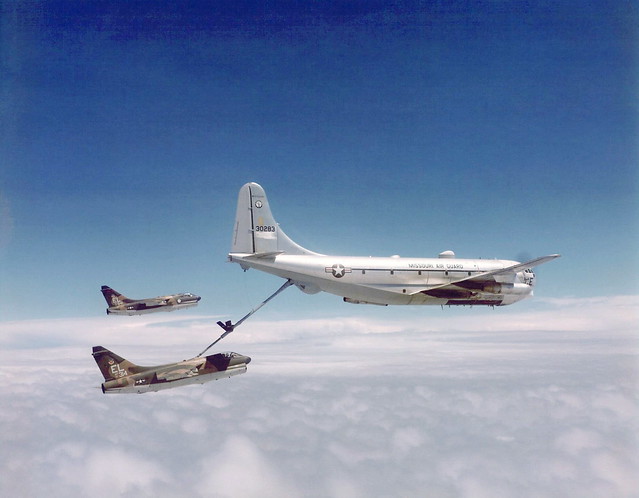
When I went through USAF pilot training in 1974, Air National Guard tanker units still flew the venerable KC-97, a piston-engined cargo aircraft first flown during WWII, later modified for aerial refueling. I didn’t know what the Air Force would send me to fly after graduation, but like my classmates I hoped it would be a fighter, and in-flight refueling was a part of every fighter pilot’s job.
As it turned out, the day I pinned on my silver wings the Air Force invited me to be a T-37 instructor pilot in the training command, an offer I couldn’t refuse. Since jet trainers didn’t do aerial refueling, I didn’t hook up to a tanker until three years later, when I finally started flying fighters. My first aerial refueling was on the boom of a jet-engined KC-135 in the skies over southern Arizona in 1978. The last of the Air Guard KC-97s went to the Boneyard that year, and I never did take gas from a prop tanker.
You ask the old fighter jocks who refueled behind prop tankers and they’ll tell you it could be hairy, slowing a Century-series fighter down to match speeds with a lumbering piston-powered tanker in the rough air at 15,000 feet, shaking and shuddering on the end of the boom with your throttle at mil or even cracking the burner to stay out of the stall. I’ve talked to B-47 and B-52 veterans too, and they say it was the same: second cousin to a daredevil act.
My purpose here is to describe the early days of USAF aerial refueling: the piston-engined tankers in use from the late 1940s into the 1970s and the different methods used to pass fuel from tankers to receivers. I’ll skip over the early in-flight refueling experiments of the 1920s and 30s, as well as the limited use of in-flight refueling for trans-Atlantic British seaplanes in the late 1930s, and confine myself to the post-WWII years and the tankers and techniques used by the USAF. In a subsequent Air-Minded article I’ll write about my own air refueling experiences and the jet-engined tankers currently in use.
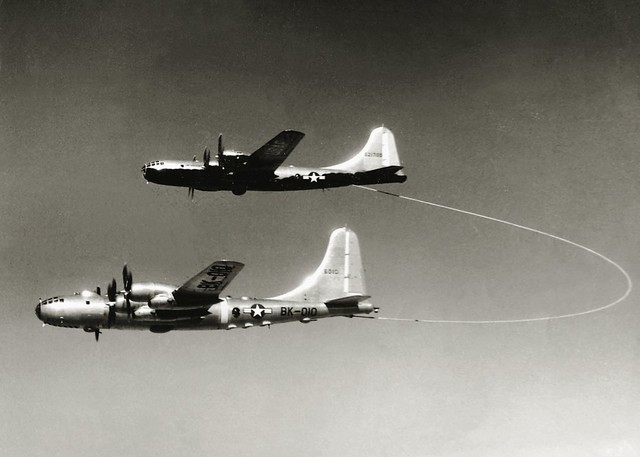
The top aircraft in the photo is a KB-29 (K for tanker, B for bomber). The lower aircraft is the B-50 Lucky Lady II, which was on a 1949 circumnavigation of the globe. Lucky Lady II took off from Carswell AFB in Texas and landed there 94 hours later, refueled four times in flight by four pairs of KB-29 tankers flying out of Davis-Monthan AFB in Arizona. The refueling method used was a looped hose.
The looped-hose method had been pioneered by the British before WWII and adapted by the USAF after the war. As used by the USAF, the receiving aircraft trailed a line with a grapple on the end. The tanker flew behind the receiver, trailing another line with a weight at the end so that it hung down almost vertically below the tanker. The tanker would cross sides behind the receiver so that the receiver’s grapple would snag the tanker’s line. The tanker then reeled in the receiver’s line to attach the refueling hose. Finally, the receiver reeled in line and hose, and after the hose was connected to the receiver the tanker would begin pumping fuel.
The USAF, on this historic flight, was demonstrating the global reach of its strategic bomber force, then made up of WWII-era B-29s and improved post-war B-50s. The truth, though, was that we had only two squadrons of KB-29 tankers at the time, and refueling with looped hoses was complex, clumsy, and slow. It’s one thing to refuel a single bomber on a round-the-world publicity stunt; it’s another thing to simultaneously refuel squadrons of bombers on their way to Moscow.
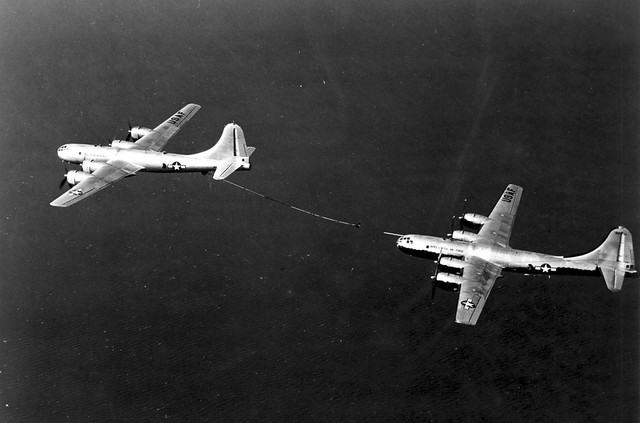
Strategic Air Command wanted a way to transfer more fuel to more bombers, at a faster rate. The USAF in 1949 adapted another British-developed method, modifying its KB-29 tankers to use the hose and drogue method. With this method, the tanker reels out a hose with a para-drogue on the end. The drogue stabilizes the free end of the hose in flight and contains the refueling coupling. It has the appearance of a large badminton shuttlecock. The receiving aircraft is equipped with a fixed or extendable probe which the receiving pilot flies into the drogue. It was a simpler method, easier for both tanker and receiver aircrews to execute, and one that didn’t require a lot of modifications to the tanker. The USAF was by this time converting a number of B-50 bombers to KB-50 tankers; these, along with the older KB-29s still in use, were fitted with hose & drogue drum housings.
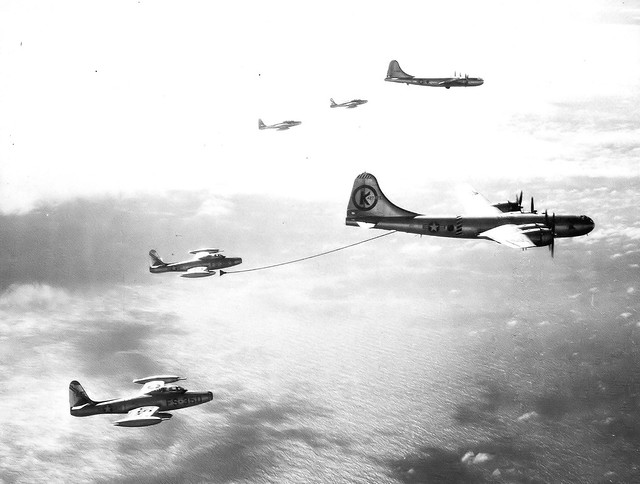
In the above photo, the KB-29s appear to be equipped with a single hose & drogue mounted in the tail; some versions also had wingtip pods and could refuel three fighters at once, as could the newer KB-50s. The ability to refuel more than one receiver at a time is a great advantage of the hose & drogue method, but when it comes to refueling large bombers, you can really only pass gas to one receiver at a time, and the fuel flow rate through the flexible hose is restricted. It was great for fighters, though, and the first combat use of aerial refueling occurred during the Korean War, with KB-29s refueling F-84s (by “great for fighters” I’m referring to the hose & drogue method, not the KB-29, which so much slower than the jet fighters it refueled that speed compatibility became a problem).
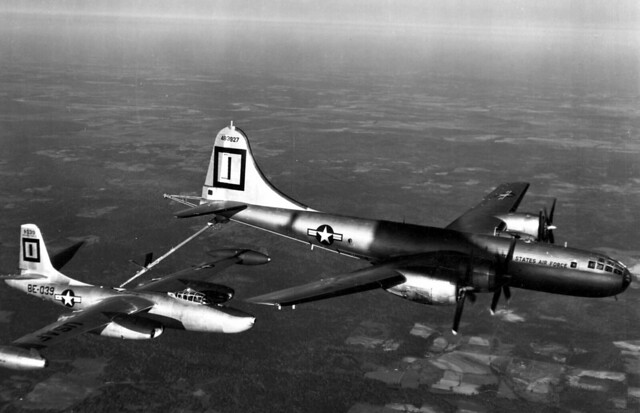
SAC was still looking for a better way to refuel bombers in mid-air, and this led Boeing to develop the flying boom, first installed on some modified KB-29s in 1950. Only one boom could be fitted to a tanker, and it required extensive modifications as well the addition of a dedicated crewmember to fly the boom and connect it to the receiving aircraft. Boom-equipped tankers could pump a great volume of fuel at a high rate, though, and in time this method of aerial refueling became the USAF standard.
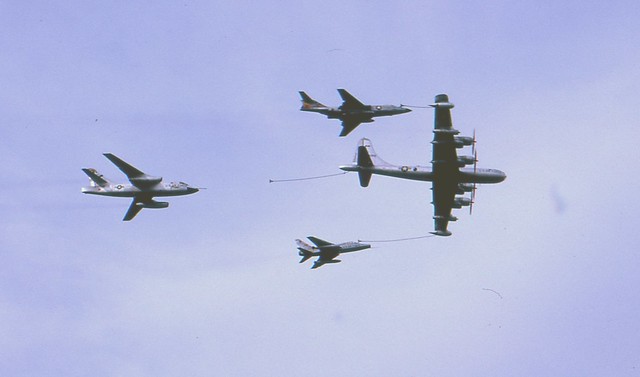
KB-50 tankers, which began replacing KB-29s in the mid-1950s (and which flew for the USAF into the 1960s), were modified B-50 bombers no longer needed after SAC began flying the B-36, B-47, and B-52. Each KB-50 was fitted with three hose & drogue drums, one near each wingtip and one in the tail (KB-50s were never modified with flying boom systems). The KB-50 flew faster than the KB-29 and reduced some of the speed compatibility problems experienced with its predecessor; the addition of outboard jet engines in 1957 gave it even more speed. The KB-50s were operated by Tactical Air Command and primarily used to refuel fighter and reconnaissance aircraft, not SAC bombers, which refueled behind another tanker, the KC-97 (C for cargo).
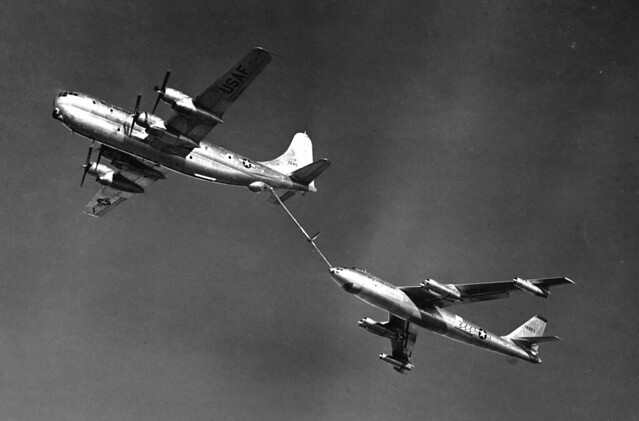
The KC-97 Stratotanker (properly called the Stratofreighter), flown by the USAF from 1951 to 1978, was the most numerous of the prop tankers, with 811 built. As with the KB-29 and KB-50, it had two separate fuel systems: one for the aviation fuel used by its own piston engines, one for the jet fuel to be pumped into receiving aircraft. It was initially operated by SAC bombardment groups and air refueling wings, primarily to support jet bombers like the B-47 and B-52, but after the KB-29s and KB-50s were phased out, to refuel USAF fighter and reconnaissance aircraft as well. As jet tankers began entering the SAC inventory in the late 1950s, KC-97s went to the Tactical Air Command, the Air Force Reserve, and the Air National Guard.
The KC-97 was slow and speed compatibility issues never went away, but the addition of jet engines in the early 1960s helped to some degree. With or without jet engines, though, KC-97s often had to “toboggan” when refueling jet fighters and bombers, going into a shallow dive during refueling to achieve max speed.
All KC-97s had a flying boom, but some were also retrofitted with hose & drogue drums stripped from retired KB-50s. Additionally, a bolt-on hose & drogue could be fitted to the end of the boom, but of course this modification had to be done on the ground before missions that required it.
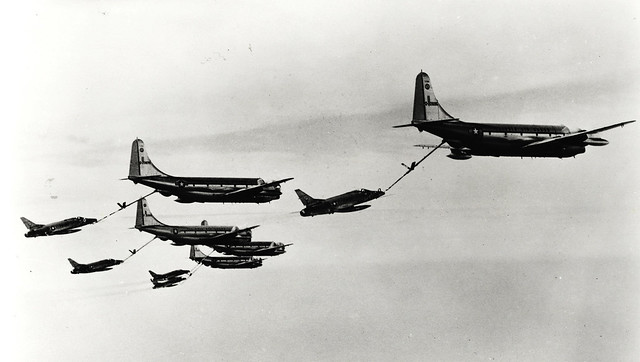
This photo is particularly interesting. F-100s had retractable probes and could only refuel using the hose & drogue method. Each of these tankers has a hose & drogue attached to the end of the boom. If you compare the attitudes of the tankers and receivers, you’ll notice a huge difference in angle of attack: the tankers are flying as fast as they can while the fighters are close to stalling out.
I’m not sure there’s a single, simple answer as to why the USAF moved from hose & drogue refueling to boom refueling. Yes, the need to transfer large amounts of fuel at a fast rate to SAC bombers drove the development of boom refueling, but even as that was happening we were still building fighters with probes for hose & drogue refueling. Bombers could accept the boom system’s high fuel flow rate; even when fighters began being equipped with receptacles for boom refueling, though, they couldn’t take on fuel much faster than they could through a hose, and the tankers had to pump fuel at a slower rate.
The simplest answer may boil down to numbers: we had a hell of a lot of KC-97s, all of them equipped for boom refueling and only a few with hose & drogue capability, and in the 1950s and early 1960s, SAC was in the driver’s seat. Today, all USAF fighters, bombers, and air-refuelable transports use the boom, and the only hose & drogue aircraft we operate are helicopters.
Nevertheless, then and now USAF tankers are tasked to support non-USAF aircraft, and virtually everyone else (the Navy and Marines, allied nation air forces) uses hose & drogue. This is a constant problem for mission planners, who must ensure tankers are equipped with compatible refueling systems before tasking them … but that’s a topic for my next tanker article, the one about jet tankers.
References:
- Wikipedia: Aerial Refueling
- History of In-Flight Refueling
- Boeing KB-29 and KB-50 Tankers
- KC-97 Stratotanker
- Air Force Aerial Refueling Methods: Flying Boom versus Hose-and-Drogue
- My Flickr Photo Album: Early Tankers (includes detail photos of Pima Air & Space Museum’s KB-50 and KC-97)
Very informative as always, thanks. Can’t wait to read the jet tanker post. But I’m slowing down to savor reading the last of your air-minded back pages, enjoyed every one.
You were fortunate and in the right place at the right time. With that downright boring 100-1 air combat ratio the F-15 pilots will always be asked…’how in the world?’ You always score high for accuracy in your posts and your writing and photography skills are exceeded only by your basic humanity. Thanks.
‘Tod’ recently posted…ERCO Ercoupe Light Sport Aircraft: Antique Flying Art